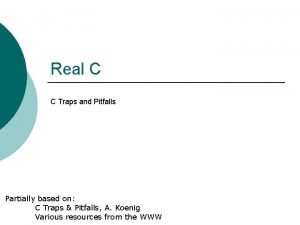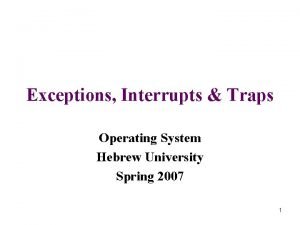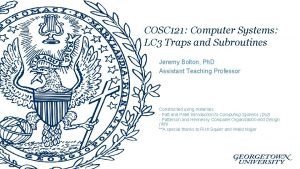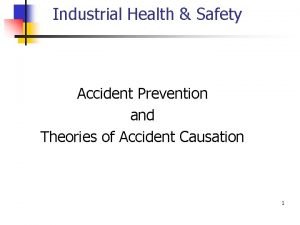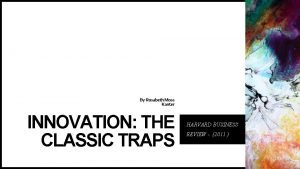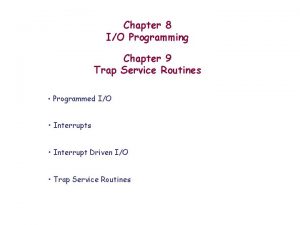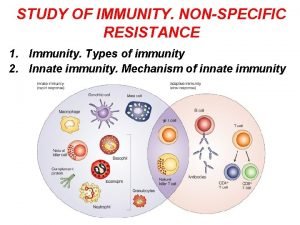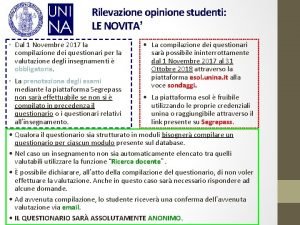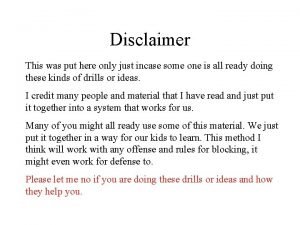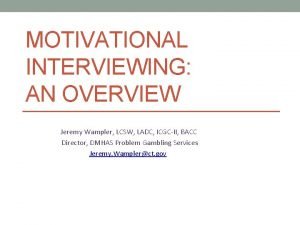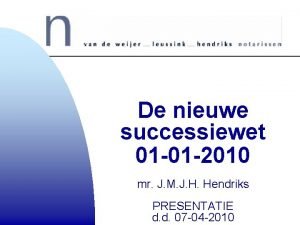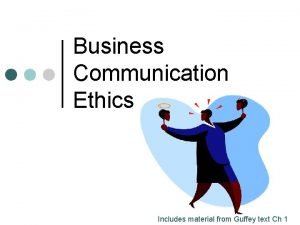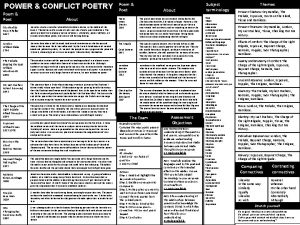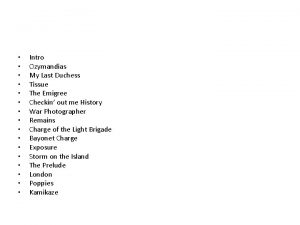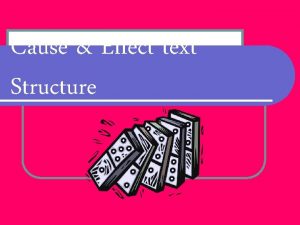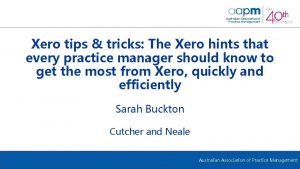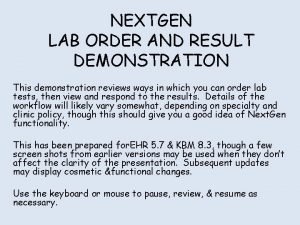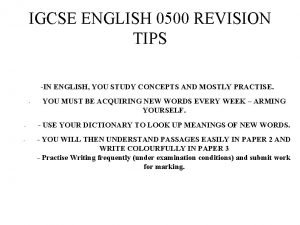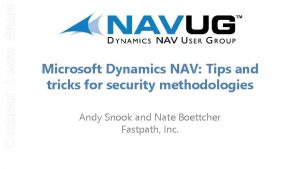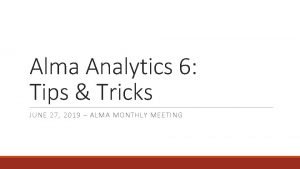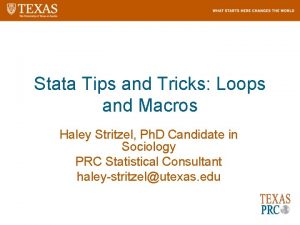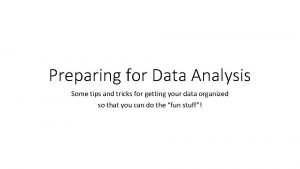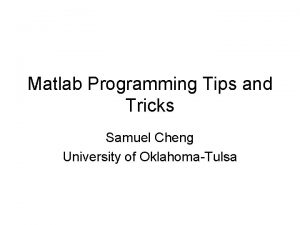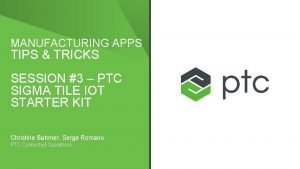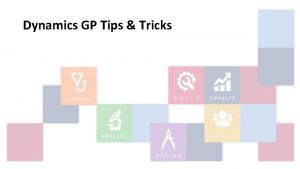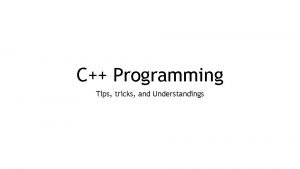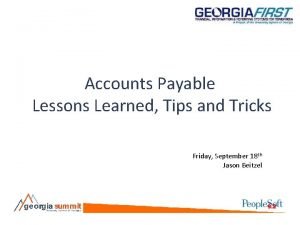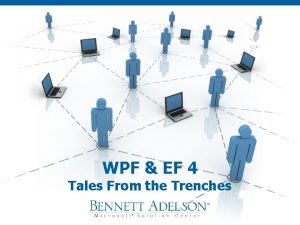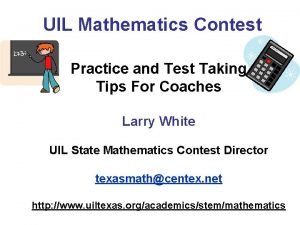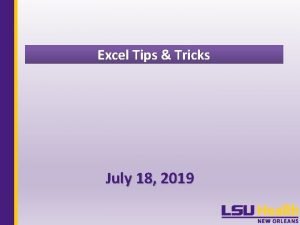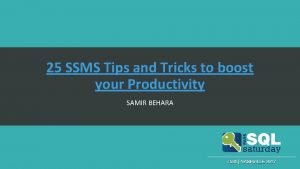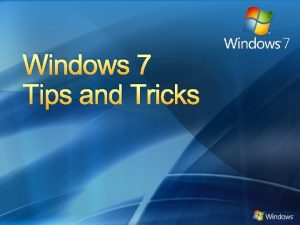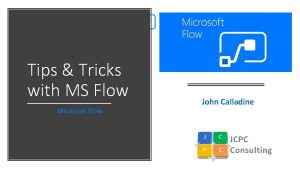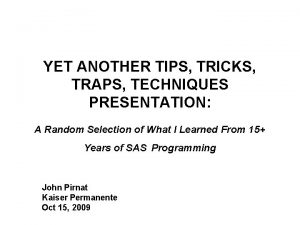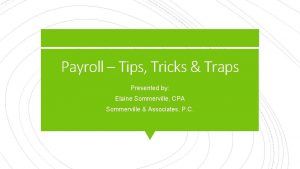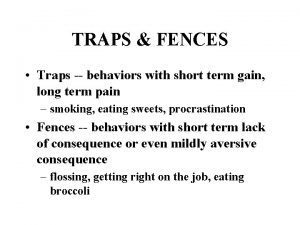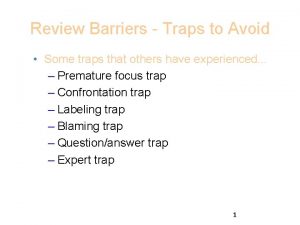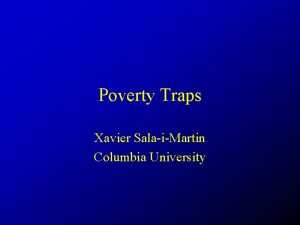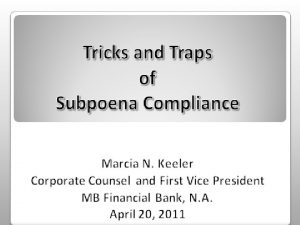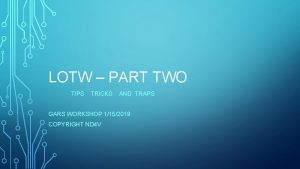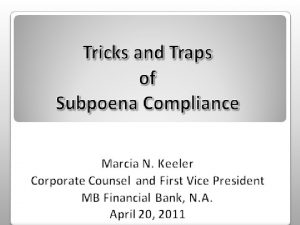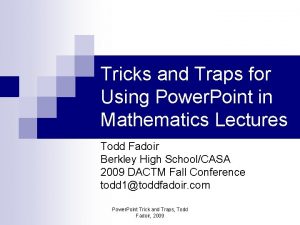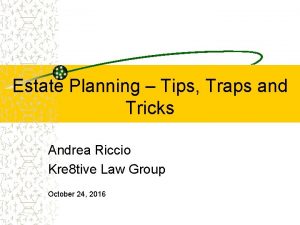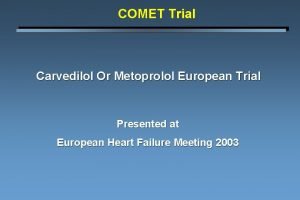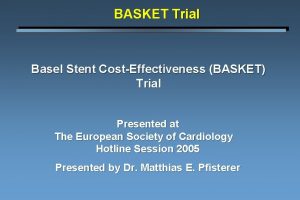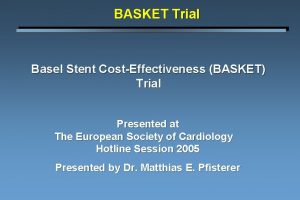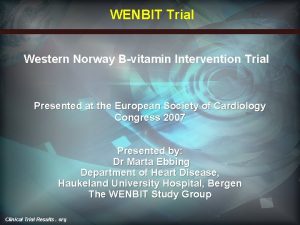TOP 10 TRIAL TRAPS TRICKS AND TECHNIQUES Presented


































































- Slides: 66

TOP 10 TRIAL TRAPS, TRICKS, AND TECHNIQUES

Presented by: Judge Joyce Draganchuk Ingham County Circuit Court

TTT #1 Your client wants to fire you

Self-representation requirements People v Williams, 470 Mich 634 (2004) 1. Defendant’s request must be unequivocal 2. The Court must determine that it is knowing, intelligent, and voluntary 3. It must not disrupt, inconvenience, or burden the Court 4. The Court must comply with MCR 6. 005(D) by advising defendant of (a) the charge (b) the max/min sentence (c) the risks (d) advisory counsel

Disruptive defendant who is selfrepresented Where the defendant is disruptive (or seemingly manipulative), the selfrepresentation may be denied based on your finding that it would be an undue inconvenience and burden on the court. People v Ahumada, 222 Mich App 612 (1997)

Self-representation requirements Judge must re-affirm at each proceeding

Defendant wants new court-appointed attorney Substitution = good cause + will not unreasonably disrupt the judicial process Good cause = legitimate difference of opinion develops with regard to a fundamental trial tactic

TTT #2 This jury looks nothing like my client

Distinguish 2 different challenges 1. Batson challenge: People v Knight, 473 Mich 324 (2005) (a) applies to the use of peremptory challenges on individual jurors (b) must be made before jury is sworn (c) remedy is to start over 2. Challenge to the venire (a) based on the 6 th Amendment: right to an impartial jury drawn from a fair cross section of the community (b) bigger issue than just one trial

Batson challenge 1. Defendant must show a prima facie case of discrimination (a) he/she is a member of a cognizable group (b) the proponent has exercised a peremptory challenge to exclude a member of a certain racial group from the jury pool (c) all the relevant circumstances raise an inference that the proponent of the challenge excluded the prospective juror on the basis of race

Batson challenge 2. The prosecutor may rebut the defendant’s prima facie case with a race-neutral reason for dismissing the juror(s) – it need not be persuasive or even plausible – just facially valid

Batson challenge 3. The trial court must determine whether the prosecutor’s explanation is a pretext for discrimination. This is a credibility issue for the trial court.

Challenge to the venire (1) The group alleged to be excluded must be a distinctive group in the community; (2) The representation of this group in venires from which juries are selected is not fair and reasonable in relation to the number of such persons in the community; and (3) The underrepresentation is due to systematic exclusion of the group in the jury -selection process.

TTT #3 Defendant does not like his outfit

The defendant is denied due process where his clothing impairs the presumption of innocence Defendant waives when he voluntarily chooses to stand trial in jail clothing – Make a record that clothes are available – Judge does not have to warn him of prejudice

The defendant is denied due process where his clothing impairs the presumption of innocence ü A timely request to be dressed in civilian clothes must be granted. People v Lee, 133 Mich App 299 (1984) ü Where the trial court observes defendant’s clothing and finds it does not look like prison garb, the appellate court will defer to the trial court and only review for an abuse of discretion. People v Harris, 201 Mich App 147 (1993)

Examples of trial court findings that were upheld • Blue pants and shirt look like what young people wear now and differs from prisoner’s clothes. People v Harris, 201 Mich App 147 (1993) • Defendant’s clothes resemble work clothes. People v Woods, 32 Mich App 358 (1971) • A white t-shirt. People v Ealy (unpub 6 -19 -12)

TTT #4 The prosecutor has not turned over evidence

Discovery violations Is it about a witness or a tangible object that the pros. is using at trial? [see list MCR 6. 201(A)] OR Is it exculpatory evidence; a police report; defendant, co-def or accomplice statement; search warrant; agreement for testimony? [MCR 6. 201(B)] OR Is it something that was ordered for good cause shown? [MCR 6. 201(I)] IF NO TO ALL → no discovery violation IF YES TO ANY → discovery violation

Discovery violations Did def. have actual knowledge? (e. g. notes transcribed into report or def’s own statement) ↓ YES No prejudice No remedy NO → Does the late disclosure cause actual prejudice? If actual prejudice, proceed to remedy

Discovery violations Remedy (balancing interests of courts, public, and parties including reason for non-compliance): 1. Order to provide 2. Permit inspection 3. Continuance 4. Allow evidence of non-production 5. Jury instruction 6. Exclude (most egregious case) 7. Mistrial (if it impairs a fair trial) 8. Dismissal --flagrant --wanton --conscious --intentional

TTT #5 Defendant is disruptive/assaultive

Disruptive defendant 1. Right to be present 2. Warnings 3. Chances to reform/return

Options • Remove him from courtroom and use video. • Gag him. People v Kerridge, 20 Mich App 184 (1970), reversed on other grounds in People v Parker, 393 Mich 531 (1975), cited with approval in People v Conley, 270 Mich App 301 (2006)

Procedure • Allow defendant to see and hear • Break after direct to allow counsel to consult before cross • Have counsel ask defendant at each consultation whether he want to return to the courtroom

TTT #6 Witness violates sequestration order

WHAT was ordered? ü there is no sequestration order unless the judge actually ordered it ü if you ask that witnesses not be in the courtroom, you should also ask that they not discuss their testimony ü if there is no order not to discuss testimony, then there is no violation when they do

WHY was the order violated? Was it on purpose or accidental?

WHO violated the order Crime victim? Crime Victim’s Rights Act allows victim to remain in the courtroom after 1 st testifying (but compare Const. 1963, art 1, § 24 allowing victim to attend trial and all proceedings defendant has the right to attend)

WHO violated the order? Prosecution witness? ü Consider the purpose behind sequestration – did the witness hear things that pertained to that witness’s testimony? ü MRE 615: “the court may order witnesses excluded so that they cannot hear the testimony of other witnesses”

WHO violated the order? Defense witness? Consider the purpose behind sequestration and whether it would deprive the defendant of a defense if the witness is precluded from testifying

DISCRETION OF COURT Choose the appropriate remedy: 1. Nothing 2. Contempt 3. Permit cross-exam on the violation 4. Preclude witness from testifying

TTT #7 Witness fails to appear

Prosecutor requests adjournment MCR 2. 503(B)(1) Subpoenaed witness → due diligence is shown by service of the subpoena and it is an abuse of discretion to deny adjournment and dismiss case. People v Jackson, 467 Mich 272 (2002) Unsubpoenaed witness → due diligence hearing and due diligence finding required for adjournment

Prosecutor requests to use P/E testimony MRE 804(a)(5) and 804(b)(1) 1. The witness is absent from the hearing, and 2. Due diligence is shown

Witness FTA after trial started Bench warrant (if subpoenaed) ü ü Contempt Use as a tool to get witness there during trial Usually prosecution uses this MCL 767. 40 a

TTT #8 Defendant fails to appear after jury sworn

Defendant may waive right to be present by voluntary absence A defendant's voluntary absence from the courtroom after trial has begun waives his right to be present and does not preclude the trial judge from proceeding with the trial to conclusion. People v Swan, 394 Mich 451 (1975)

Judge Kenny’s checklist q The local county jail and adjoining county jails q Two major hospitals in the area q County morgue q Post Office q Residence and employment address q School system if witness or defendant has school age children

TTT #9 Witness takes the 5 th

The Rule A lawyer may not call a witness who is intimately related to the criminal episode at issue when it is known that the witness will assert the Fifth Amendment privilege against self-incrimination. People v Giacalone, 399 Mich 642 (1977).

Procedure where it is known witness may assert the 5 th People v. Poma, 96 Mich App 726 (1980); People v Dyer, 425 Mich 572 (1986) 1. Proceed outside the presence of the jury 2. Appoint counsel 3. Hold hearing where first it is established that the witness understands the privilege (because either counsel has advised or the judge explains)

Procedure where it is known witness may assert the 5 th People v. Poma, 96 Mich App 726 (1980); People v Dyer, 425 Mich 572 (1986) 4. Have the proponent ask the intended questions 5. If the witness asserts the 5 th to any questions, verify that the witness intends to do so if called before the jury 6. The judge, not the witness, determines whether the assertion of the privilege is valid or not (based on a reasonable belief)

Procedure where it is known witness may assert the 5 th People v. Poma, 96 Mich App 726 (1980); People v Dyer, 425 Mich 572 (1986) 7. If the judge determines that the privilege being asserted is not valid, the judge may proceed with contempt finding 8. If witness persists in taking the 5 th, whether a valid assertion or not, the witness may not be called to the stand

Procedure when it is not known in advance that the witness will assert the 5 th • There is none! • Follow People v Poma and People v Dyer • Give jury instruction if requested

TTT #10 The judge and/or prosecutor is out of line

Judicial Intervention Control the courtroom and interrogation of witnesses under MRE 611 Pierce the veil of judicial impartiality Deny fair trial

Examples of what is acceptable • Make evidentiary rulings. People v Jackson, 292 Mich App 583 (2011) • Comment on the evidence to the extent that it explains a ruling. People v Walker (unpub COA, 3 -31 -16) • Interrupt attorney or witness who is about to state something irrelevant or inadmissible. People v Ullah, 216 Mich App 669 (1996); People v Grimmett, 27 Mich App 509 (1970) • Raise the issue of defendant’s competency to stand trial where there is a bona fide doubt about his competency. People v Groeneveld, 54 Mich App 424 (1974)

Examples of what is acceptable • Intervene when a witness is subject to harassment or undue embarrassment. MRE 611(a) • Admonish an attorney who deserves it (but best done outside presence of jury). People v Daniel, supra • Ask witnesses questions aimed at clarification or to produce fuller and more exact testimony or elicit additional relevant information. MRE 614(b); People v Stevens, 498 Mich 162 (2015) • Inform the jury that a fact is established if the defendant admits occurrence. People v Hamer, 19 Mich App 318 (1969) (“a man died”)

Examples of what is acceptable • Propose giving an instruction that is applicable even when it has not been requested. • Propose giving a lesser-included offense instruction even when it has not been requested. People v Till, 115 Mich App 788 (1982)

A conviction will be reversed where the judge pierces the veil of judicial impartiality • Violates constitutional guarantee of a fair trial • Consider totality of circumstances • It is reasonably likely that the judge’s conduct improperly influenced the jury by creating the appearance of advocacy or partiality against a party • There is no harmless error analysis; it is automatic reversal

Examples of what is not acceptable • Taking on questioning of a witness in the manner of an advocate. People v Stevens, 498 Mich 162 (2015) • Demonstrating a special relationship with a juror to the extent that the juror may have more influence than other jurors. People v Collier, 168 Mich App 687 (1988) • Saying in the context of ruling on evidence that the defendant’s theory left the jury with a false impression. People v Walker (unpub COA, 3 -3116)

Examples of what is not acceptable • Telling the jury that they cannot leave until they have reached a verdict. People v London, 40 Mich App 124 (1972) (2 -day trial went to the jury at 10: 55 p. m. and they had a verdict at 11: 13 p. m. ) • Demonstrating moral indignation over witness’s extra-marital affair with defendant. People v Bledsoe, 15 Mich App 459 (1969)

Examples of what may not be acceptable • Finding defense attorney in contempt and jailing him during trial. People v Rauch, unpublished COA No. 345330 (rel’d 12/19/19) • Berating, scolding, and demeaning a lawyer so as to hold him up to contempt in the eyes of the jury destroys the balance of impartiality. People v Wilson, 21 Mich App 36 (1969)

Almost everything can be fixed ‘I did reprimand Mr. Sherman at one point quite strongly. I don't want you to infer it was in any sense against him or against his client. It shouldn't reflect on his client at all. He made a critical error. And I am sure it was due to inadvertence or oversight when he asked a particular question. Because it is almost an immutable rule of evidence that question should not have been asked. And the court did respond quite strongly and quite quickly. I want you to understand it has nothing to do with whatever consideration you should give to this case in your deliberations. ’ People v Allen, 42 Mich App 195, 197– 98; 201 NW 2 d 353, 354 (1972)

Prosecutorial misconduct (error) • Improper argument • Evidentiary issues • Aggressive conduct

No matter what the offense: 1. Make a timely and specific objection 2. Request a curative instruction if appropriate 3. Objection may not be required where it could not have cured the error or a failure to review the issue would result in a miscarriage of justice

People v Stanaway, 446 Mich 643 (1994)

ALMOST everything can be fixed • • Similarly, the admission of this improper statement that had the effect of a confession in the minds of the jury was not an error that, under the circumstances of this case, could be cured by a cautionary instruction. This trial essentially came down to a credibility contest between the defendant and the complainant. The complainant testified about the elements of the crime; the defendant denied any sexual involvement. There is little evidence that compares to the probative weight a confession carries, particularly when delivered by a police officer. The inference from the police officer's testimony was that the defendant admitted the acts he was accused of. Any nagging doubts the jury may have had about whether these sexual incidents took place between the complainant and the defendant were likely erased by the words he purportedly uttered to his nephew. Likewise, we are of the opinion that in this case, the hearsay error was prejudicial. Under these circumstances, we conclude that allowing the police officer to present defendant's statement purportedly made to his nephew requires reversal of the defendant's conviction and a new trial. People v Stanaway, 446 Mich 643, 695; 521 NW 2 d 557, 582 (1994)

TTT #11 Motion for Mistrial

Mistrial? • Witness gives non-responsive answer with prejudicial non-admissible information in it • A report has not been provided • There is some kind of impermissible juror contact or juror misconduct • The jury is deadlocked

Mistrial standard • Test: will defendant be deprived of a fair trial? • Only grant a mistrial when the prejudicial effect of the error cannot be removed in any other way • Instructions are presumed to cure most errors

Non-responsive/prejudicial testimony “As a general rule, unresponsive testimony by a prosecution witness does not justify a mistrial unless the prosecutor knew in advance that the witness would give the unresponsive testimony or the prosecutor conspired with or encouraged the witness to give the unresponsive testimony. ” People v Hackney, 183 Mich App 516 (1990). • • Strike & tell jury to disregard Standard instruction Special instruction Nothing

Remedies short of mistrial Report not provided: – Continuance Impermissible juror contact: – Voir dire the juror/ask about taint – Voir dire other jurors to ask about taint – Release the juror at issue Deadlock – When?

Mistrial: Now What? • Defendant’s motion waives double jeopardy – get defendant’s consent • Prosecutor’s motion requires manifest necessity • Court sua sponte: manifest necessity

 C traps and pitfalls
C traps and pitfalls How to filter crawler traps
How to filter crawler traps Group polarization psychology definition
Group polarization psychology definition Brand image trap
Brand image trap Traps in operating system
Traps in operating system Lc3 trap
Lc3 trap Sediment traps construction
Sediment traps construction Brand identity traps
Brand identity traps Construction entrance
Construction entrance Steam traps 101
Steam traps 101 Functions of leaf
Functions of leaf Ten traps of interviewing
Ten traps of interviewing The human factor theory
The human factor theory Innovation: the classic traps
Innovation: the classic traps It traps heat shields the surface from harmful radiation
It traps heat shields the surface from harmful radiation Teentraps
Teentraps Trap vector table
Trap vector table Neutrophil extracellular traps
Neutrophil extracellular traps Esol unina
Esol unina Incase traps
Incase traps Vietnam war traps
Vietnam war traps Next generation security platform
Next generation security platform Palo alto networks next generation security platform
Palo alto networks next generation security platform Jeremy wampler
Jeremy wampler Oil traps
Oil traps Types of pressure control valves ppt
Types of pressure control valves ppt Happiness traps
Happiness traps 2 traps testament
2 traps testament Guffey text
Guffey text Mournful reinvasion of darkness
Mournful reinvasion of darkness Theme of hate in romeo and juliet
Theme of hate in romeo and juliet How is power presented in ozymandias
How is power presented in ozymandias How is power presented in ozymandias and my last duchess
How is power presented in ozymandias and my last duchess In this text structure the cause and effects are presented
In this text structure the cause and effects are presented Fonction technique scooter
Fonction technique scooter Xero practice manager demo
Xero practice manager demo Alteryx tips and tricks
Alteryx tips and tricks Result demonstration
Result demonstration Kronos tips and tricks
Kronos tips and tricks Igcse english tips
Igcse english tips Purpose of homework
Purpose of homework Navision tips and tricks
Navision tips and tricks Zhuang wang
Zhuang wang Alma analytics tips and tricks
Alma analytics tips and tricks Magento 2 tips and tricks
Magento 2 tips and tricks Stata tips and tricks
Stata tips and tricks Data analysis tips and tricks
Data analysis tips and tricks Matlab tips and tricks
Matlab tips and tricks Sigma tips and tricks
Sigma tips and tricks Accessibility tips and tricks
Accessibility tips and tricks Google scholar tricks
Google scholar tricks Qlik sense tips and tricks
Qlik sense tips and tricks Gp tips and tricks
Gp tips and tricks Vacuum forming companies near me
Vacuum forming companies near me C programming tricks
C programming tricks Wells fargo positive pay file format
Wells fargo positive pay file format Wpf tips and tricks
Wpf tips and tricks Uil calculator practice tests with answers
Uil calculator practice tests with answers Brand tips and tricks
Brand tips and tricks Excel tips and tricks 2019
Excel tips and tricks 2019 Kronos tips and tricks
Kronos tips and tricks Sql server management studio tips and tricks
Sql server management studio tips and tricks Windows 7 tips and tricks
Windows 7 tips and tricks Vmware tips and tricks
Vmware tips and tricks Machine learning tips and tricks
Machine learning tips and tricks Microsoft flow tips and tricks
Microsoft flow tips and tricks Koststed
Koststed
